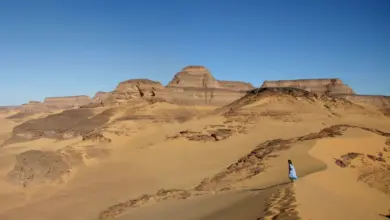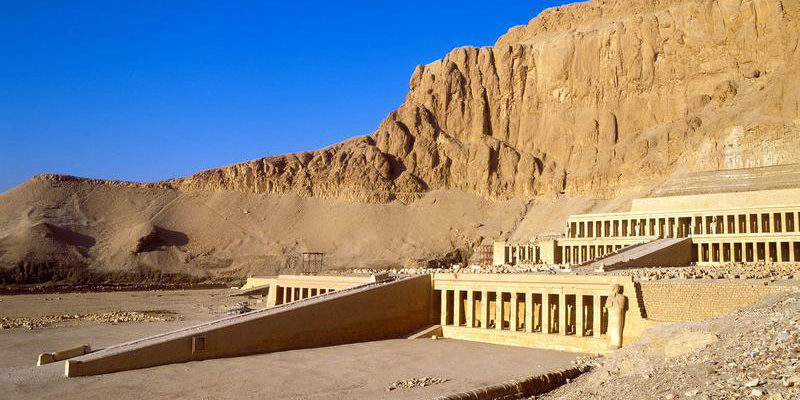"His majesty of this God has sent the God's treasurer, the assistant and leader of the troupe, Her-Wer-Re, to the mining lands and he said: there is abundant turquoise in the hill."
With these words, Chief Her-Wer-Re began documenting the work of his mining expedition sent by the pharaoh (his majesty of this God) to Serabit al-Khadem in South Sinai during the Middle Kingdom Period (ca. 2055-1985 BC). In the inscriptions on his stele at the mine, he boasts of the success of his expedition despite rumors that turquoise ore might be lacking at that particular time of year: "My expedition returned complete in its entirety … I broke off in the first month of summer, bringing my precious stone … I accomplished my work with great success without a voice being raised against my work, which I have done excellently."
Rock inscriptions left by ancient Egyptian miners in South Sinai are rich with details of working conditions and weather, as well as praise for the pharaoh and the gods. They present a lively narrative of daily life that can be easily compared to modern business reports, or even a diary.
Sinai is often referred to in Arabic as “Ard Al-Fayrouz” (the land of turquoise) after its ancient Egyptian name "Ta Mefkat" or “Khetyou Mefkat”, which means turquoise terraces. Minerals were of great use in ancient times – for making royal jewelry and divine offerings, and more importantly for mummy ornaments and amulets, encouraging pharaohs since the Early Dynastic Period (ca. 3050-2890 BC) to send mining expeditions to extract turquoise and copper from South Sinai.
Wadi Maghara, Wadi Kharig, Bir Nasb and Serabit al-Khadem were among the premium mining spots in antiquity, and visiting them today offers a different experience for history and archaeology aficionados than the temples and tombs of the Nile Valley and Delta, which reflect ancient Egyptians’ beliefs in the afterlife. The archaeological sites of Southern Sinai relay aspects of daily life in old mining communities.
Such communities documented their work and adventures in the desert through rock inscriptions, graffiti (spontaneous wall drawings done by traveling expeditions), and occasionally chapels erected for the local God Hathor – also known as the Lady of Turquoise – once miners settled in.
The chief of the expedition would oversee documentation efforts: wall carvings at the mine’s entrance state the date of the expedition, the name of the chief and the group’s achievements. At Serabit al-Khadem, inscription number 56 reads: "Gallery (mine) has been opened by Chief Sanofret and named ‘Admiring the Beauty of Hathor.’” Other inscriptions at mining sites emphasize the power of the pharaoh over regions distant from the ruling capital in the Nile Valley. In Wadi Maghara, the wall carvings executed by miners show a typical Early Dynastic scene of the pharaoh smiting a man with a mace head.
Because ancient Egyptians tended to link all their life activities to religion, the miners were also keen on offering chapels and stelae (stone slabs or columns bearing commemorative inscriptions) to the local gods.
The site of Serabit al-Khadem still preserves the remains of the largest ancient Egyptian temple in the Sinai Peninsula. Located on an elevation, almost 800 meters above sea level, the temple is built of dozens of stelae inscribed by the chiefs of ancient expeditions from both the Middle and New Kingdoms (ca. 1550-1295 BC) to honor Hathor. It is surrounded by ancient mining caves.
Miners also carved hundreds of bits of graffiti enroute to the mines. The actual archaeological spot of Rod al-'Air still acts as a resting point for today's visitors on the way up to Serabit al-Khadem, just as it did for ancient miners. While resting, one can see graffiti of boats, animals and mining tools. The graffiti is believed to refer to the boats used by expeditions to cross from the Eastern Desert to Sinai. Remains of such boats were uncovered by the archaeological mission of the French Institute of Oriental Archaeology, which has been excavating at Ain Sokhna since 2001.
Starting the 19th century, these sites were explored by European travelers and archaeologists such as the Italian explorer Alessandro Ricci in 1828, the German Egyptologist K. Richard Lipsius in 1845, and Thomas Palmer in 1869. The Sinai accounts of the great archaeologist W.M.F. Petrie (1905-1906) constitute the oldest archaeological research to bring these ancient mining sites to light. Much research on the area was also conducted from the 1970s through the 1990s. Still, most mining sites are unknown to the general public.
Besides archaeological research, this region of South Sinai has also attracted the attention of anthropologists. "The people of Serabit al-Khadem offer very interesting insights on Bedouin life," says anthropologist Sara Abu Bakr, who has worked there. "They still retain many of their traditions despite the presence of satellite dishes and mobile phones. These traditions will soon dissolve in urbanite life, so for anthropologists wanting to study remnants of Bedouin life, the place and its wonderful people present an ample chance. Life in Serabit is different and harsh; children still do not get enough education, especially girls.”
The current inhabitants of the surroundings of the ancient mines offer an invaluable case study for ethno-archaeology. Men grow up guiding tours to the ancient mines while women make beautiful handicrafts using turquoise and copper.
"As an archaeologist who has worked at the area, I think that looking at the archaeological site as stones, inscriptions and statues is a very colonial way of dealing with it, for it reduces its value to a spectacle for tourists and the elite, while it should be seen as part of the region’s local heritage and social history,"says Monica Hanna, a community archaeologist/researcher at the University of Berlin, who has also worked at Serabit al-Khadem.
Those who visit the area need to arrange their trip with local guides – usually members of dominant tribes. Locals often grow up accompanying their fathers touring visitors through the ancient mines, and children at Serabit al-Khadem usually learn to read hieroglyphic signs from archaeologists working in the region.
Although not heavily practiced nowadays, extracting turquoise ("tarkiz" in the local dialect) remains a local secret. It is very common in South Sinai, especially around the ancient mines, to find some inhabitants with small turquoise stones for sale. Although these vendors love to chat about everything, they will never mention details about how and where they extract their turquoise. Still, visitors tend to come back with a beautiful blue-green piece of turquoise from these special spots of the blessed land of Sinai.




